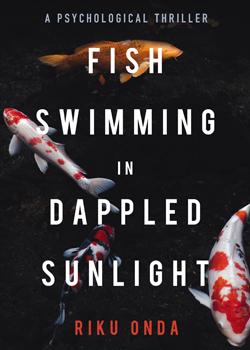Fish Swimming In Dappled Sunlight

By Onda Riku
Translated by Alison Watts
Bitter Lemon Press (2022)
ISBN-13: 978-1913394592
Review by Laurence Green
A couple meet up one final time, one last night together in which to dissect the past. Their relationship has broken down. Their apartment is now emptied and void of their possessions. All that is left is to get to the bottom of where it all went wrong; a horrific incident in which during a dreamy holiday trekking in the mountains, their guide suddenly dies. The couple each believe the other murdered the guide - but why, and how? What they desire more than anything is a confession.
Perhaps even more so than in The Aosawa Murders - Onda Riku’s previous novel to be translated into English - there is a clinical sparseness to the prose here that keeps the reader in a constant sense of unsettled anxiety. Through a constant drip-feeding of information, with paragraphs often circling around a subject for pages by way of tangents and diversions, we teeter on a precipice of what we think we know, and what we don't know. Resolution is hard to come by in Onda's uniquely creepy psychological worlds, the characters almost child-like at times in the wilful skirting of the usual hard-and-fast truths of adult rationality.
Thus we are pulled, always at the mercy of Onda's puppeteer-like hands, through a plot that slowly - ever so slowly - reveals itself. We might think of comparisons such as Kazuo Ishiguro's Never Let Me Go, or Margaret Atwood's The Handmaid's Tale - masterworks at never showing more than is absolutely necessary at any given time of the worlds that surround their protagonists. The intensity of this claustrophobia was one of the key allures of The Aosawa Murders, and it is done to perfection again here - with Alison Watts’ translation capturing with deft poise the understanding that it is often the most simplest of utterances that can convey the deepest unease.
Bit by bit, we get to know the couple at the heart of this story. Though we know their names, (or do we…?) the first person narrative that flits between their respective points of view sees them melding together into a kind of symbiotic, hydra-like existence. We can never be entirely sure what each is concealing from the other, and yet we know they share a deep bond. Who holds the dominant position, and who is struggling toward the truth? In the constant back-and-forth of their dialogue, we begin to see a sense of how they are ultimately two sides of the same coin.
Do we ever like them as protagonists? That's a more difficult question to answer - but through the time we spend in their company, they nevertheless become the only anchor we are afforded in a plot that is constantly adrift and at angles with itself. The core narrative is hard work for the reader, to be certain, and is given to us asynchronously - are we in the present, or the past? The framing device of the couple sitting in their soon to be vacated apartment, working their way through wine and shochu as they discuss their memories of the trauma that haunts them both, has a kind of weird comfort to it. It is in their recollections that we truly lose ourselves, a space divorced of any solid ground, composed of illusory fragments that loom out of the mists of forgetfulness.
It’s not until about two-thirds of the way through the book that we really begin to get a handle on what is actually at play here, and the various interlocking elements begin to make sense. We finally start to understand not only the true depths of the bond between the couple, but also the dark secret that connects both them and the dead guide. The answers, it seems, lie not in some kind of final confession, but in their childhoods - a mental space that can only be reclaimed through a reconciliation of the difference between ‘fact’ and ‘truth’.
It is very difficult to talk about the massive revelations that the book’s latter half delivers without giving anything away, but suffice to say, when they finally come, it is like a volley of punches to the gut, tearing away any remaining semblance of safety the reader has, and dangling them over an abyss of vertigo-inducing nausea. Onda toys with primal fears; insects, being buried, children in peril - and they terrify all the more because of the repetitive, cyclical manner in which they are employed. Like something from a nightmare by way of a David Lynch movie, the eerieness gets into us like a bad itch.
Although the novel could ostensibly be touted as ‘crime’ fiction, as with The Aosawa Murders, the tone is often far closer to psychological horror. Fans of the likes of Ogawa Yoko will find plenty to enjoy here, and the book’s biggest draw can be summed up in its relentless probing and unpicking of the deepest recesses of morality. What drives us to act the way we do? Who are we really? And can we ever - even with those closest to us - know the inner thoughts of another? Time and again, Onda forces us to confront the ugly truths behind these questions. In doing so, she comes very close to conveying in the textual format what it might mean to be ‘human’, with all the messy, fallible connotations associated with it.

